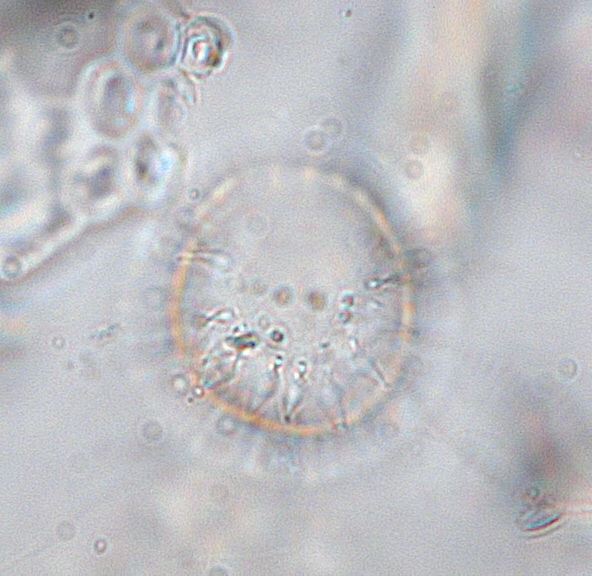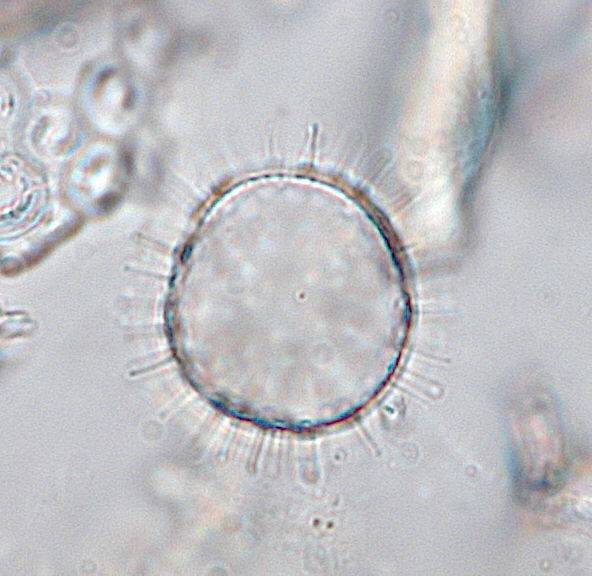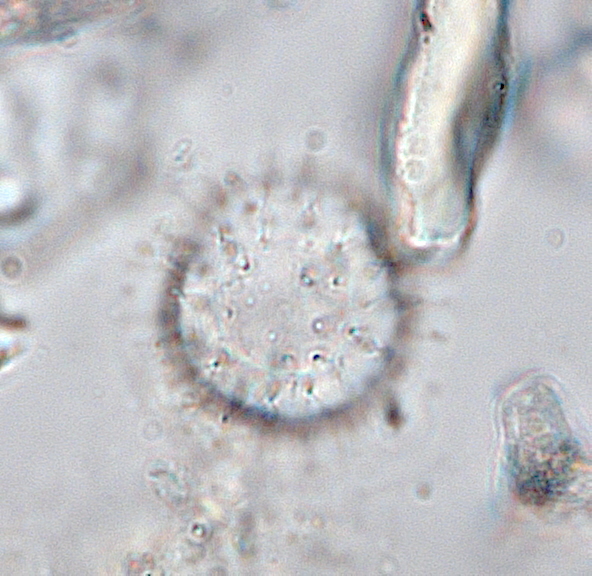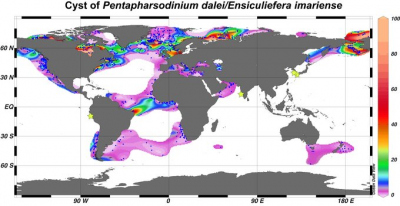Page path:
- Modern Dinocyst Key
- transparent cysts
- randomly distributed processes
- transparant cyst with solid processes
- Pentapharsodinium dalei
Pentapharsodinium dalei

Sample CBi-5-6 off Cape Blanc NW Africa
Photograph Karin Zonneveld


Field characteristics
Cyst of Pentapharsodinium dalei Indelicato et Loeblich III 1986
Field characteristics:
Small proximochorate sphaerical cyst, with a variable density of processes. Cyst wall is smooth. Processes are solid, with distinctive distal terminations, and may be branched or more commonly unbranched. Processes vary in width, and both slender and broader examples may occur on the same specimen. Archeopyle is of chasmic type. No other indication of tabulation.
Dimensions: Cyst body diameter: 19 to 36 µm, length of processes: 1 to 8 µm.
Cyst-theca relationship: Dale, 1977
Stratigraphic range: lower Pleistocene to Recent.
Comparison with other species:
This species looks very much like Operculodinium centrocarpum. You can distinguish it by the presence of solid rather than hollow processes and the presence of at least one branched process. The processes can vary in shape, not only between specimens but also on one cyst. The appearance of the processes are often similar to those of O. centrocarpum but there are always a few on a cyst that are branced. The overall appearance of these cysts is that they are much more fragile, thinner walled as O. centrocarpum.
Field characteristics:
Small proximochorate sphaerical cyst, with a variable density of processes. Cyst wall is smooth. Processes are solid, with distinctive distal terminations, and may be branched or more commonly unbranched. Processes vary in width, and both slender and broader examples may occur on the same specimen. Archeopyle is of chasmic type. No other indication of tabulation.
Dimensions: Cyst body diameter: 19 to 36 µm, length of processes: 1 to 8 µm.
Cyst-theca relationship: Dale, 1977
Stratigraphic range: lower Pleistocene to Recent.
Comparison with other species:
This species looks very much like Operculodinium centrocarpum. You can distinguish it by the presence of solid rather than hollow processes and the presence of at least one branched process. The processes can vary in shape, not only between specimens but also on one cyst. The appearance of the processes are often similar to those of O. centrocarpum but there are always a few on a cyst that are branced. The overall appearance of these cysts is that they are much more fragile, thinner walled as O. centrocarpum.
Geographic distribution based on :
Zonneveld et al., 2013. Atlas of modern dinoflagellate cyst distribution based on 2405 datapoints. Review of Palaeobotany and Palynology, v. 191, 1-197
Zonneveld et al., 2013. Atlas of modern dinoflagellate cyst distribution based on 2405 datapoints. Review of Palaeobotany and Palynology, v. 191, 1-197
Cysts of Pentapharsodinium dalei/Ensiculifera imariense can be regarded to represent a polar to equatorial, euryhaline cosmopolitan species complex that can be observed in high relative abundances in all environments covered by this Atlas with exception of the arctic regions.

Distribution:
Cysts of Pentapharsodinium dalei/Ensiculifera imariense are observed in polar to equatorial regions. The arctic front (Northern Hemisphere) and the subtropical front (Southern Hemisphere) form the northern and southern boundaries of its distribution. Pentapharsodinium dalei/Ensiculifera imariense can dominate (>50%) in the Hudson Bay, off Iceland (North Atlantic Ocean), the North Sea, the Barents Sea, the Chukchi Sea and the Bering Sea. It can form up to 96% of the association in these regions. It is abundant in the open ocean as well as in sediments of coastal sites.
Environmental parameters:
SST: -2.1 - 29.5°C (spring - summer) with summer SST > 0°C. SSS: 11.3 - 39.3 (autumn - autumn), [P]: 0.06 - 1.87 μmol/l, [N]: 0.01 - 26.5 μmol/l, chlorophyll-a: 0.08 - 20.9 ml/l, bottom water [O2]: 0.01 - 8.2 ml/l.
Cysts can be abundant in sites where upper water temperatures < 0°C throughout the year except during summer. Cysts of Pentapharsodinium dalei/Ensiculifera imariense occur in full marine environments where upper water salinities are reduced throughout the year as a result of meltwater or river input. This species complex is not restricted to regions with specific trophic conditions in the upper waters. Although cysts of Pentapharsodinium dalei/Ensiculiefera imariense occur in sediments where anoxic and hypoxic conditions prevail in bottom waters, relative abundances increase with bottom water oxygen concentrations.
Comparison with other records:
Apart from the sites included in this Atlas cysts of Pentapharsodinium dalei/Ensiculifera imariense are recorded from the Indian Ocean (Godhe et al., 2000), the Peruvian upwelling area (Biebow et al., 1993), Imari Bay, southwestern Japan (Kobayashi and Matsuoka, 1995) and coastal sediments of southern South Korea (Pospelova and Kim, 2010).
In the Arctic, cysts of Pentapharsodinium dalei/Ensiculifera imariense are observed in areas that can be covered by sea ice for up to 9 to 12 months a year although a slight negative relationship between its relative abundance and annual ice cover can be distinguished (de Vernal et al., 1998; Radi and de Vernal, 2008; Howe et al., 2010). It is observed in Svalbard fjords with much less sea ice (Grøsfjeld et al., 2009).
Sediment trap and seasonal distribution studies do generally not reveal a clear seasonal pattern in the cyst production of Pentapharsodinium dalei/Ensiculifera imariense. Cysts of Pentapharsodinium dalei /Ensiculifera imarienseare are produced throughout the year in the North Atlantic Ocean. In the Somali Basin, highest cyst production occurs at times of active upwelling during the southwest Monsoon (Zonneveld and Brummer, 2000). In the Georgia Strait (British Columbia) cysts of Pentapharsodinium dalei/Ensiculifera imariense have been observed in one of the studied years only without showing a seasonal production pattern. In the Saanich Inlet (British Columbia) its production is negatively related to the amount of Fraser River output, upper water temperature, biogenic silica concentrations in the trap sediments and solar insolation. Its production is however positively correlated to precipitation in the area, wind speed and cloud cover (Pospelova et al., 2010; Price and Pospelova, 2011). In an arctic in a fjord north of Svalbard, high production of this species is observed in a short periods in summer/ to late autumn related to full arctic conditions with stratified high productivity conditions (Howe et al., 2010).
A recent study on eutrophication trends in the Mediterranean Sea reveals that cyst production of Pentapharsodinium dalei/Ensiculifera imariense increases when upper water phosphate concentrations increase (Zonneveld et al., 2012).
Note, so far no morphological difference between cysts of Pentapharsodinium dalei and Esiculifera imariense have been described and it is therefore not possible to date to differenciate their geographic distribution.
Cysts of Pentapharsodinium dalei/Ensiculifera imariense are observed in polar to equatorial regions. The arctic front (Northern Hemisphere) and the subtropical front (Southern Hemisphere) form the northern and southern boundaries of its distribution. Pentapharsodinium dalei/Ensiculifera imariense can dominate (>50%) in the Hudson Bay, off Iceland (North Atlantic Ocean), the North Sea, the Barents Sea, the Chukchi Sea and the Bering Sea. It can form up to 96% of the association in these regions. It is abundant in the open ocean as well as in sediments of coastal sites.
Environmental parameters:
SST: -2.1 - 29.5°C (spring - summer) with summer SST > 0°C. SSS: 11.3 - 39.3 (autumn - autumn), [P]: 0.06 - 1.87 μmol/l, [N]: 0.01 - 26.5 μmol/l, chlorophyll-a: 0.08 - 20.9 ml/l, bottom water [O2]: 0.01 - 8.2 ml/l.
Cysts can be abundant in sites where upper water temperatures < 0°C throughout the year except during summer. Cysts of Pentapharsodinium dalei/Ensiculifera imariense occur in full marine environments where upper water salinities are reduced throughout the year as a result of meltwater or river input. This species complex is not restricted to regions with specific trophic conditions in the upper waters. Although cysts of Pentapharsodinium dalei/Ensiculiefera imariense occur in sediments where anoxic and hypoxic conditions prevail in bottom waters, relative abundances increase with bottom water oxygen concentrations.
Comparison with other records:
Apart from the sites included in this Atlas cysts of Pentapharsodinium dalei/Ensiculifera imariense are recorded from the Indian Ocean (Godhe et al., 2000), the Peruvian upwelling area (Biebow et al., 1993), Imari Bay, southwestern Japan (Kobayashi and Matsuoka, 1995) and coastal sediments of southern South Korea (Pospelova and Kim, 2010).
In the Arctic, cysts of Pentapharsodinium dalei/Ensiculifera imariense are observed in areas that can be covered by sea ice for up to 9 to 12 months a year although a slight negative relationship between its relative abundance and annual ice cover can be distinguished (de Vernal et al., 1998; Radi and de Vernal, 2008; Howe et al., 2010). It is observed in Svalbard fjords with much less sea ice (Grøsfjeld et al., 2009).
Sediment trap and seasonal distribution studies do generally not reveal a clear seasonal pattern in the cyst production of Pentapharsodinium dalei/Ensiculifera imariense. Cysts of Pentapharsodinium dalei /Ensiculifera imarienseare are produced throughout the year in the North Atlantic Ocean. In the Somali Basin, highest cyst production occurs at times of active upwelling during the southwest Monsoon (Zonneveld and Brummer, 2000). In the Georgia Strait (British Columbia) cysts of Pentapharsodinium dalei/Ensiculifera imariense have been observed in one of the studied years only without showing a seasonal production pattern. In the Saanich Inlet (British Columbia) its production is negatively related to the amount of Fraser River output, upper water temperature, biogenic silica concentrations in the trap sediments and solar insolation. Its production is however positively correlated to precipitation in the area, wind speed and cloud cover (Pospelova et al., 2010; Price and Pospelova, 2011). In an arctic in a fjord north of Svalbard, high production of this species is observed in a short periods in summer/ to late autumn related to full arctic conditions with stratified high productivity conditions (Howe et al., 2010).
A recent study on eutrophication trends in the Mediterranean Sea reveals that cyst production of Pentapharsodinium dalei/Ensiculifera imariense increases when upper water phosphate concentrations increase (Zonneveld et al., 2012).
Note, so far no morphological difference between cysts of Pentapharsodinium dalei and Esiculifera imariense have been described and it is therefore not possible to date to differenciate their geographic distribution.


